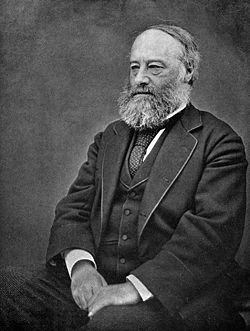James Prescott Joule
James Prescott Joule (24 December 1818 – 11 October 1889) was an English physicist and brewer, born in Salford, Lancashire.

Biography
James Prescott Joule was born in Salford, Lancashire, England on 24 December, 1818. While young, Joule was mostly home-schooled but also studied Geometry and Arithmetic under John Dalton, an English chemist, physicist, and meteorologist who laid the framework for modern atomic theory. He was also later taught by the famous scientist John Davies, and was influenced greatly in his early years by chemist William Henry.
Joule's occupation as an adult was the management of the family brewery. His pursuit of scientific discoveries was merely a passionate hobby.Around the year 1840 he decided to investigate the feasibility of replacing his brewery's steam engines with one powered by the newly invented electric motor. This led him to a desire to determine the efficiency of steam compared to the efficiency of electricity. His discovered Joule's first law in 1841, which states: "the heat which is evolved by the proper action of any voltaic current is proportional to the square of the intensity of that current, multiplied by the resistance to conduction which it experiences." He realized that the steam engine of his time was more efficient and economical than the new electric motors, Joule developed a common standard to provide the output of alternative methods. The foot-pound defined as the ability to raise one pound a height of one foot.
However, having achieved his initial goal, Joule broadened his inquisitiveness and set out to determine how much work could be extracted from a given source. While working on this question he performed experiments and published results which showed that the heating effect he had quantified a few years earlier was due directly to the generation of heat within the conductor. This went squarely against the prevalent caloric theory of the time which stated that heat could not be created or destroyed, but merely transferred from one medium to another.
Major Contributions to Physics
Joule Heating
Joule Heating or Resistive Heating is a process by which the flow of a current through a conductor with some resistance releases heat. The square of the current in the conductor is proportional to the amount of heat produced according to the formula:
- [math]\displaystyle{ H \propto I^2 \cdot R \cdot t }[/math]
Joule first studied resistive heating in 1841 through a variety of experiments. He submerged a length of wire in a predetermined mass of water and created current flow through the wire. He then let the current flow for a length of time and measured the rise in the water temperature. By varying the length of the wire and the current he was able to empirically deduce that the heat released was proportional to the current flowing through the wire, he was able to tease out the Joule heating formula as stated above.
Joule's work with energy and his disproving of caloric theory eventually led to the conservation of energy principle and the SI unit of energy was subsequently named the joule, being given the symbol J. The commonly known unit of power, the watt, is equivalent to one joule per second.
Joule heating is caused by interactions between the atomic ions making up a conductive material and the moving particles that form the current flowing through the conductor. The moving particles in an electric circuit are accelerated by an electric field and thus gain kinetic energy, which they give up each time they collide with an ion. These collisions manifest as heat and raise the temperature of the conductor as well as the temperature of everything the conductor is in thermal contact with.
Heat's relationship to Mechanical Work
As Joule continued this experimentation with this electric motor, he was able to estimate the mechanical equivalent of heat to raise the temperature of a pound of water by one degree Fahrenheit to be 838 ft·lbf of work. At a meeting of the chemical section of the British Association for the Advancement of Science in August 1943 Joule announced his findings but was met by silence and disbelief.
Joule remained unfazed and now realized that he must perform a purely mechanical experiment converting work into heat. He achieved this by measuring the viscous heating of water after he forced it through a perforated cylinder and obtained a mechanical equivalent of 770 ft·lbf/Btu of work. He believed he had compelling evidence since the work values he calculated through electric and purely mechanical experimentation were fairly close.
"Wherever mechanical force is expended, an exact equivalent of heat is always obtained" -J.P. Joule, August, 1843
Joule decided to try a third and final route to calculating the conversion of mechanical work into heat. He compressed a gas by performing some amount of work and measured the heat generated by the process. This time he obtained a mechanical equivalent of 798 ft·lbf/Btu, and was able to defeat his skeptical critics through some clever experimentation procedures. His findings were finally published in the Philosophical Magazine in 1945.
Connectedness
There are many practical applications of the discoveries made by James Joule:
1) An incandescent light bulb glows when the filament is heated by Joule heating.
2) Electric stoves and other electric heaters usually work by Joule heating.
3) Electric fuses are designed based on the idea that enough current flow will generate enough heat to melt the fuse wire.
4) Electronic cigarettes usually work by Joule heating, vaporizing propylene glycol and vegetable glycerine.
5) Certain Food processing equipment makes use of Joule heating to produce food. The food material itself provides the electrical resistance and heat is released internally to the food.
See also
Energy Transfer due to a Temperature Difference
References
https://en.wikipedia.org/wiki/James_Prescott_Joule